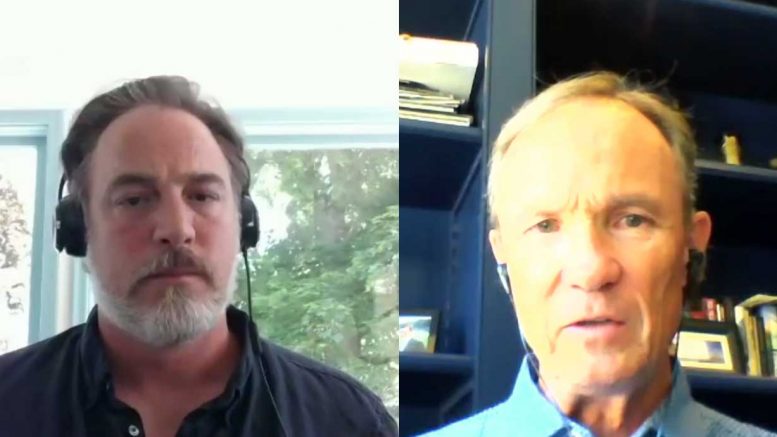The fifth instalment of the Canadian Mining Symposium kicked off on June 16. In light of the Covid-19 pandemic, this year’s event has been moved from the auspicious setting of Canada House in London, U.K., to the virtual realm.
The symposium now boasts over 2,166 attendees from 83 countries consisting of mining experts from across the spectrum, including CEOs, managing directors, and presidents to geologists, investors, and mining consultants.
Anthony Vaccaro, Group Publisher of The Northern Miner and Head of Global Mining for Glacier Resource Innovation Group, opened the symposium with some introductory remarks.
He touched upon some key themes for the symposium as well as current world events.
“With the move to a virtual platform, we are no longer confined to the 200-person capacity of the main room at Canada House but have taken the event to well over 1,000 participants from around the world,” Vaccaro said.
Although the event has become increasingly global, Vaccaro added, it is still all about the people. He thanked the sponsors and speakers for their help in making the event possible, given the current circumstances.
“We have an exciting, informative, and can’t-miss few days ahead of us,” Vaccaro said. “Over these three days, the symposium will give you a very comprehensive view of where the mining industry sits at this unparalleled time.”
He took the opportunity to address the anti-racism protests following the murder of George Floyd in Minneapolis last month. He delivered a strongly-worded rebuke of racism and its impacts.
“The mining industry has presented many of us with the opportunity to travel the globe and work with many people of different religions, backgrounds, and races,” he said. “It’s very difficult to travel the world and hold a racist viewpoint.”
While acknowledging that its diagnosis is simple enough, racism’s consequences can be devastating and deadly, with the death of George Floyd being just one tragic example.
Floyd’s death, he added, has galvanized a significant amount of the world’s population to “steer our collective journey to a more equitable and compassionate place.”
The symposium then started in earnest with Dean McPherson, Head of Business Development at the TMX Group.
McPherson discussed the development and execution of the exchange’s global strategy for tracking new listings in the mining sector on the TSX Stock Exchange and TSX Venture Exchange.
McPherson set the scene for the symposium by delivering a fascinating presentation on the global mineral exploration and mining industry and the pre-eminent position that Canada holds in the industry.

TMX Group head of business development Dean McPherson (left) and Northern Miner group publisher Anthony Vaccaro (right) give opening remarks to the Canadian Mining Symposium on Zoom.
“If you’re considering entering the global equities market, then Canada should be your first consideration,” he said. “The TSX is at the centre of the Canadian capital markets and, by extension, global capital markets.”
Around 1,138 mining companies, McPherson noted, are listed on the TSX and TSXV, with 86 on the TSX and 542 on the TSXV, all based in Canada. Around $117 billion in global equity capital was raised over the past five years, of which 37% was on the Toronto exchanges.
Nearly 47% of the over 5,200 mineral exploration projects on the TSX and TSXV are outside of Canada, and 45% of the global mining properties are located in Canada, he noted.
McPherson also highlighted Canada’s “pragmatic security regime” as critical to nurturing and supporting the growth of mining and exploration companies. In particular, its benign environment for class-action lawsuits, secondary market liability capped at 5% of issuers’ market capitalization, and the directors and officers liability capped by statute.
Vaccaro then introduced Jeff Parshley, group chairman and practice leader at SRK Consulting.
Parshley moderated a thought leadership panel entitled, Beginning at the End: How Can We Optimize the Socioeconomic Legacy of Mine Closure?
He was joined by Boubacar Bocoum, a leading mining specialist from the World Bank, Kevin P.C.J. D’Souza, Centerra Gold’s (TSX; CG) vice president of security, sustainability, and environment, and Charlene Wrigley, group sustainable development manager with Gold Fields (NYSE: GF).
The panel discussed how the transitioning of a community, region, or country from a mining economy to a post-mining economy could be achieved.
One of the critical points, Parshley said, was that closures need to be considered at the beginning of mining activities.
“We’ve made considerable progress in the technical aspects of mine closures,” he noted. “Although the socioeconomic impacts of mine closures have been required for decades in several jurisdictions, it wasn’t until the publication of the Mining and Minerals Sustainable Project report, in 2002, that the socioeconomic impacts of mine closures were raised.”
The panel agreed that the best mine closure outcomes occur in jurisdictions with good governance, with considerable progress in recent years for companies operating in Russia and Africa.
“As we learn more about integrated mine closure practices,” Gold Fields’ Wrigley said, “we realized the importance of engaging with all stakeholders, including government, host communities, employees, and even shareholders.”
It was also important, she said, to consider the broad and integrated nature of all stakeholders to plan effectively and to ensure that communities can become more self-sufficient and less dependent on mining companies by the time they transition or mine closure occurs.
A clear understanding of the relinquishment criteria, Centerra Gold’s D’Souza noted, should occur at the beginning of the project and should be agreed between all the stakeholders, in particular the future custodians of the land.
Through his work at the World Bank, Bocoum primarily works with developing countries. He felt that the emphasis should be on the sustainable development aspects of mine closures rather than the environmental, which has traditionally been the approach.
Cecilia Jamasmie, a senior editor at Mining.com, then introduced Ashley Kirwan, co-founder, CEO, and principal geologist at Orix Geoscience, an exploration consulting services company. Kirwan was the first featured speaker of the day.
In 2016, Ashley was recognized as one of the 100 Global Inspirational Women in Mining. In 2018, she was awarded the Distinguished Alumni Rising Star Award from Laurentian University.
More recently, Ashley was awarded the 2020 YMP Eira Thomas Award for entrepreneurialism and was selected as one of the 2019 ‘Top 40 Under 40’ award winners for the City of Greater Sudbury.
In going back to mine principles – in geology and business – Kirwan, who described herself as a “geologist turned entrepreneur,” talked about the need to go back to basics. Specifically, she focused on how increases in exploration spending have not resulted in an increase in value over the last decade.
Kirwan noted that, over the past decade, US$198 billion had been spent on exploration to deliver US$109 billion of value. Although technology is improving every day, money spent on exploration should also be “paired with fresh ideas,” she said. Companies need to be “more strategic with how exploration dollars are spent.”
“If dollars spent on exploration are increasing, then we have to do everything we can to increase the pipeline of good-quality, sustainable assets that keep testing the geological story based on science, observations, and fresh ideas,” Kirwan said.
In her presentation, Kirwan advocated for a “back to basic principles” approach for fostering fresh ideas predicated on “people, the rocks, legacy information and human intelligence.”
In particular, Kirwan spoke of the importance of building a diverse and engaged team that comprises “leaders, not managers, that are creative and passionate, value expertise over experience, especially at upper levels of management, and recognize that everyone has different values and need different things.”
Anthony Vaccaro then joined Sean Boyd, Agnico Eagles Mine’s (TSX: AEM; NYSE: AEM) vice-chairman and CEO, the keynote speaker, for a fireside chat.
Since Boyd was appointed CEO ten years ago, Agnico has grown from a single-mine gold producer to a multi-mine, international gold company, Vaccaro noted.
Boyd has been recognized as The Northern Miner’s person of the year in 2007 and 2017, and appeared on the list of the best performing CEOs in the world in the Harvard Business Review in 2010, 2016, and 2017.
Vaccaro opened the conversation by asking Boyd whether, given the shuttering of mines due to the Covid-19 outbreak, was this difficult period “one of the most challenging times in his long tenure at the company?”
“It has been because of the complexity and the speed at which decisions were being made and the speed at which the information set was changing,” Boyd said. “And when you layer on that a lot of these issues were related to people, then that just increased the intensity of the challenge.”

Northern Miner group publisher Anthony Vaccaro (left) interviews Agnico Eagle Mines chairman and CEO Sean Boyd (right) at the Canadian Mining Symposium on Zoom.
Of their eight mines operated by Agnico, the Kittila gold mine in northern Finland was the only mine that remained open during the pandemic, Boyd noted. Not only did the mine keep operating, he said, but also produced an underground record tonnage in April, and then surpassed it in May.
Even with their North American mines shuttered, Boyd said he was confident that the company would be able to reach the production levels in the second half of the year that were seen in the last quarter of 2019.
“The gold will always be there, so we saw this an opportunity to contribute to our communities,” he added.
Specifically, Boyd highlights the efforts and vision that his team employed in testing for the coronavirus ahead of many other industries. The company, Boyd said, tested all its employees in Nunavut, Canada and Finland. As a consequence, they were able to “layer on an extra level of protection and comfort level for our employees as they returned to work.”
By testing early, Boyd noted, Agnico was able to bring that experience to their operations in Quebec.
The conversation then segued to Environment, Social and Governance (ESG), with Vaccaro asking Boyd about his thoughts on where the industry currently stands on its ESG performance.
“The industry needs to do a better job of articulating the positive benefits of mining. We’re very good on the environmental side, as we live with that every day, but we don’t talk about the good things that are done,” Boyd said.
Although he believes that the industry is doing well on the governance side, he noted that it appears to be more like an academic discussion.
Boyd argued that for Agnico, governance comes down to “what are you doing for your communities, your employees,” and he highlighted the company’s “We make money work” initiative that promotes the positive work the company has done in the social governance arena.
Boyd, for example, drew attention to the company’s involvement in a food program in Nunavut with the provision of food baskets to 450 families and a similar program in northern Mexico.
He also acknowledged the importance of building partnerships with the local community and being aware that, as a company, you are “visitors on someone else’s land,” and so have to work hard on the relationship.
The conversation then turned to the current bull run on gold markets, with Vaccaro asking if lessons can be learned from previous bull markets.
“The number one question and the number one theme in all our investor meetings is ‘will it be different this time?’” Boyd responded.
Investors, he said, will be asking themselves, “how can they be sure the margins they expect to see as gold prices go higher will be captured by the companies, and then how some of it can be returned to me as an owner?”
Boyd believes there are two fundamental differences between the current bull run on gold and the bull run 12 years ago, which, he believes, boded well for the next 3 to 5 years.
The first, he noted, is that the industry is not currently experiencing the same levels of input price pressures that the industry experienced in 2008. Secondly, between 2005 and 2008, gold prices increased three-fold, from below US$400 to around US$1,200 per ounce.
“What you had over that period was a massive dilution in the quality of the underlying mine plans supporting the future of the businesses at the time,” Boyd said.
Because the gold price assumption jumped from generally from around US$350 per ounce most companies were using in reserves to US$800, US$900, US$1,000, US$1,200, he said.
“Companies didn’t realize that by doing this, all their reserves were growing, which made it much harder for the operators to hit production targets, but more importantly, to maintain unit costs,” Boyd said.
“We don’t have that now, and the foundation of the business for the next five to ten years has been based on roughly a US$1,200 [per ounce] gold price, and will not change dramatically over the next two to three years, so the mine plans underpinning the business for the next five to ten years are solid.”
In the last session of the day, Adrian Pocobelli, online editor and host of The Northern Miner podcast, talked with Gordon Stothart, president and CEO of IAMGOLD (TSX: IMG).
Pocobelli opened the conversation by asking Stothart about the origin of the company’s name.
“The company was founded as a junior company on the Sadiola gold deposit in Mali, West Africa, and was named International African Minerals Gold” Stothart explained.” They wanted to call it ‘IAMGOLD’, but felt it was a little too cheeky.”
The story of IAMGOLD, he added, comes from the days of Mansa Musa, who ruled over the Mali Empire around 750 years ago and was known as the golden king of Mali.
“As the legend goes, he travelled to Europe and gifted so much gold to the pharaoh he destroyed the price of gold for a generation,” Stothart added. “When asked upon presenting himself who he was, he replied, ‘I am gold.’”
Stothart joined IAMGOLD in 2007 as chief operating officer and became president and CEO on March 1, 2020. Before joining IAMGOLD, he worked in the Noranda-Falconbridge-Xstrata organization for over 20 years, including ten years working on large copper mining operations in South America.
“I was raised on a farm in the Okanagan Valley of British Columbia, but I didn’t want to become a farmer,” Stothart said, “so, I went to school and became an engineer, but was sure that I didn’t want to work in the city either.”
Given the variety of activities involved in the mining industry compared with other engineering disciplines, he added, the mix of business and engineering in mining appealed to him. So, he decided to work in the industry.
The conversation turned to the impact of the Covid-19 outbreak and the impacts on IAMGOLD, particularly given the timing of Stothart’s appointment as CEO of the company.
“Around 12 days after assuming the role, I was in self-quarantine and have been stuck in the house working out of my son’s old bedroom ever since,” Stothart said. “But because of the quality of our team, we were able to move pretty quickly in the Canadian context when the situation popped up in mid-March.”
The company, he noted, had one of the earliest Covid-19 cases at its head office in Toronto, which prompted the company to shut down and to transition to a work-from-home mode around the middle of March.
IAMGOLD then formed a crisis response committee for each of the exploration sites, he added. Because of the emergency’s scope, the company also formed an ad hoc committee called the Operations Covid Committee to act as a liaison between the sites and corporate and ensured that the medical response at the sites was appropriate and co-ordinated.
“I’d give the company a ‘B’ in response to Covid-19,” he noted. “I don’t think we dropped any balls along the way, but overall we’ve been able to take it in our stride as well as look for some advantages.”
Having currency and fuel price hedges in place, he noted, allowed us to take some advantage of the currency shifts to find the “rose in the snow” amongst the impacts from the Covid-19 outbreak.
Apart from the Sadiola and Yatela gold mines in Mali, IAMGOLD also operates two gold mines in Suriname and Burkina Faso. These have experienced ongoing security issues with the threat of attacks from Islamist radical groups like Boko Haram operating in Burkina Faso and the shooting death, last August, of an artisanal miner by local police in Suriname.
In response, the company suspended operations at its Rosebel gold mine in Suriname, about 85 km south of the country’s capital, Paramaribo.
“In Suriname and Bukina Faso we have been leading the security effort,” Stothart said. “We have been pretty forthright about spending money that was required on security there.”
The company, he added, has been spending around US$50 million a year on a mix of operating costs and investment in security infrastructure and has been working closely with the governments in the region to help manage the situation.
Stay tuned for more conference coverage.






Be the first to comment on "Canadian Mining Symposium opens with industry stalwarts Sean Boyd, Ashley Kirwan and Gord Stothart"